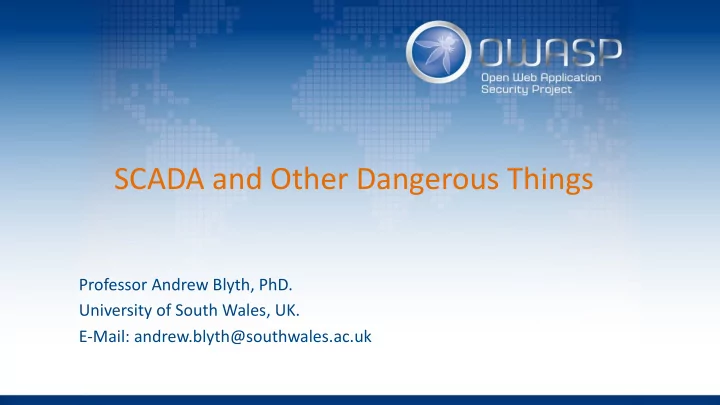

SCADA and Other Dangerous Things Professor Andrew Blyth, PhD. University of South Wales, UK. E-Mail: andrew.blyth@southwales.ac.uk
SCADA and Ukraine
SCADA Hacking
Typical SCADA Critical Infrastructure Architecture 4
SCADA and IPC Forensic Challenges ➢ Why do challenges exist? ➢ IPC/SCADA systems designed to automate, monitor and control Critical Infrastructure were originally designed for isolated, air gapped networks ➢ Now interconnected with many networks and communicating via Internet ➢ Span huge geographical areas ➢ Include many proprietary and legacy devices and protocols ➢ Lack of security mechanisms in SCADA protocols ➢ No real guidance or methodologies for data acquisition at the control level 5
SCADA Forensic Challenges ➢ Data Sources ➢ Variety of data sources, amount of data sources ➢ Live Acquisition ➢ Verification ➢ Response Time ➢ Logging and Storage ➢ Absence of Dedicated Forensic Tools 6
SCADA Forensic Challenges ➢ Data Sources ➢ Live Acquisition ➢ Latency, interference and OOV (Order of Volatility) ➢ Verification ➢ Response Time ➢ Logging and Storage ➢ Absence of Dedicated Forensic Tools 7
SCADA Forensic Challenges ➢ Data Sources ➢ Live Acquisition ➢ Verification ➢ Calculating hash values ➢ Response Time ➢ Logging and Storage ➢ Absence of Dedicated Forensic Tools 8
SCADA Forensic Challenges ➢ Data Sources ➢ Live Acquisition ➢ Verification ➢ Response Time ➢ Span huge geographical areas, many field sites ➢ Logging and Storage ➢ Absence of Dedicated Forensic Tools 9
SCADA Forensic Challenges ➢ Data Sources ➢ Live Acquisition ➢ Verification ➢ Response Time ➢ Logging and Storage ➢ Audit/logging functions disabled, minimal storage ➢ Absence of Dedicated Forensic Tools 10
SCADA Forensic Challenges ➢ Data Sources ➢ Live Acquisition ➢ Verification ➢ Response Time ➢ Logging and Storage ➢ Absence of Dedicated Forensic Tools ➢ No real methodologies for data acquisition from PLCs 11
IPC/SCADA Forensic Incident Response Model 12
SCADA Forensic Incident Response Model ➢ Stage 1: Prepare ➢ Understand system architecture ➢ Understand system requirements ➢ Understand potential attacks 13
SCADA Forensic Incident Response Model ➢ Stage 2: Detect ➢ Determine type of attack ➢ Determine infected areas ➢ Stage 3: Isolation ➢ Containment of infected areas in relation to business operations 14
SCADA Forensic Incident Response Model ➢ Stage 4: Triage ➢ Identify data sources ➢ Prioritize data sources ➢ Stage 5: Respond ➢ Perform data acquisition ➢ Perform data analysis 15
SCADA Forensic Incident Response Model ➢ Stage 6: Report ➢ Review findings ➢ Create report ➢ Update system architecture ➢ Update system requirements 16
Questions 17
Recommend
More recommend